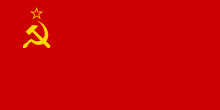Soviet patriotism is the socialist patriotism involving emotional and cultural attachment of the Soviet people to the Soviet Union as their homeland.[1] It is also referred to as Soviet nationalism.[2]

Manifestation in the Soviet Union edit
Stalin emphasized a centralist Soviet socialist patriotism that spoke of a collective "Soviet people" and identified Russians as being the "elder brothers of the Soviet people".[3] During World War II, Soviet socialist patriotism and Russian nationalism merged, portraying the war not just as a struggle of communists versus fascists, but more as a struggle for national survival.[3] During the war, the interests of the Soviet Union and the Russian nation were presented as the same, and as a result Stalin's government embraced Russia's historical heroes and symbols, and established a de facto alliance with the Russian Orthodox Church.[3] The war was described by the Soviet government as the Great Patriotic War.[3] After the war, nationalism was officially included into the ideology of the Soviet Union. Nationalities deemed "unreliable" were persecuted, and there were widespread deadly deportations during the Second World War.[4]
Nikita Khrushchev moved the Soviet government's policies away from Stalin's reliance on Russian nationalism.[3] Khrushchev promoted the notion of the people of the Soviet Union as being a supranational "Soviet People" that became state policy after 1961.[5] This did not mean that individual ethnic groups lost their separate identities or were to be assimilated but instead promoted a "brotherly alliance" of nations that intended to make ethnic differences irrelevant.[6] At the same time, Soviet education emphasized an "internationalist" orientation.[6] Many non-Russian Soviet people suspected this "Sovietization" to be a cover for a new episode of "Russification", in particular because learning the Russian language was made a mandatory part of Soviet education, and because the Soviet government encouraged ethnic Russians to move outside of Russia and settle in other Soviet republics.[6]
Efforts to achieve a united Soviet identity were severely damaged by the severe economic problems in the Soviet Union in the 1970s and 1980s resulting in a wave of anti-Soviet sentiment among non-Russians and Russians alike.[6] Mikhail Gorbachev presented himself as a Soviet patriot dedicated to address the country's economic and political challenges, but he was unable to restrain the rising regional and sectarian ethnic nationalism, with the USSR breaking up in 1991.[6]
Socialist patriotism and bourgeois nationalism edit
Under the outlook of international communism that was especially strong at the time, Lenin separated patriotism into what he defined as proletarian, socialist patriotism from bourgeois nationalism.[1] Lenin promoted the right of all nations to self-determination and the right to unity of all workers within nations, but he also condemned chauvinism and claimed there were both justified and unjustified feelings of national pride.[7] Lenin explicitly denounced conventional Russian nationalism as "Great Russian chauvinism", and his government sought to accommodate the country's multiple ethnic groups by creating republics and sub-republic units to provide non-Russian ethnic groups with autonomy and protection from Russian domination.[3] Lenin also sought to balance the ethnic representation of leadership of the country by promoting non-Russian officials in the Communist Party of the Soviet Union to counter the large presence of Russians in the Party.[3] However, even at this early period the Soviet government appealed at times to Russian nationalism when it needed support - especially on the Soviet borderlands in the Soviet Union's early years.[3]
Contemporary Chinese nationalism in the People's Republic of China, in particular the variant endorsed by the Communist Party of China has been said to have been modelled on Soviet nationalism.[3]
Contemporary Soviet patriotism edit
In modern day Russia, the Communist Party of the Russian Federation is often said to follow the ideology of Soviet patriotism.[8]
In many post-Soviet states such as Russia, Ukraine, Moldova, Belarus, Kazakhstan and others, there exists nostalgia for the Soviet Union, primarily among the older generation of people.[9][10] Soviet symbolism and propaganda has been utilized by the Russian forces during the Russo-Ukrainian War (especially during the 2022 Russian invasion of Ukraine), to legitimize the actions of the Russian forces in Ukraine.
See also edit
References edit
- ^ a b The Current digest of the Soviet press , Volume 39, Issues 1-26. American Association for the Advancement of Slavic Studies, 1987. Pp. 7.
- ^ Dobrenko, Evgeny (2020-07-14). Late Stalinism. Yale University Press. p. 466. ISBN 978-0-300-19847-8.
- ^ a b c d e f g h i Motyl 2001, pp. 501.
- ^ Naimark, Norman M. (2002-09-19). "The Background to the 1944 Deportations / Chechens and Ingush / The Chechens-Ingush during World War II". Fires of Hatred: Ethnic Cleansing in Twentieth-Century Europe. Harvard University Press. ISBN 978-0-674-97582-8.
- ^ Motyl 2001, pp. 501–502.
- ^ a b c d e Motyl 2001, pp. 502.
- ^ Christopher Read. Lenin: a revolutionary life. Digital Printing Edition. Oxon, England, UK; New York, New York, USA: Routledge, 2006. Pp. 115.
- ^ Bozóki & Ishiyama, p245
- ^ "Ностальгия по СССР" [Nostalgia for the USSR] (in Russian). levada.ru. 19 December 2018.
- ^ Maza, Christina (19 December 2018). "Russia vs. Ukraine: More Russians Want the Soviet Union and Communism Back Amid Continued Tensions". Newsweek. Retrieved 20 December 2018.
Bibliography edit
- Motyl, Alexander J. (2001). Encyclopedia of Nationalism, Volume II. Academic Press. ISBN 0-12-227230-7.